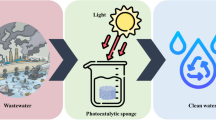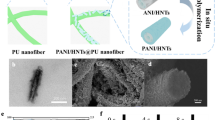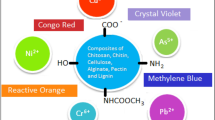Abstract
In the current study, poly(vinyl alcohol)/alginate/chitosan (PVA/Alg/CS) composite nanofiber was immobilized with six different ratios of nanomagnetic zinc oxide (M-ZnO) (0 wt%, 0.2 wt%, 0.4 wt%, 0.6 wt%, 0.8 wt%, and 1 wt%) via the electrospinning technique. The various fabricated composite (M-6) nanofibers were characterized using Fourier transform infrared (FTIR), X-ray diffractometer (XRD), vibrating sample magnetometer (VSM), scanning electron microscope (SEM), atomic force microscope (AFM), thermogravimetric analysis (TGA), mechanical testing machine, and optical contact angle measurement. The fabricated composite nanofibers were applied for the adsorption of phenol from aqueous solutions. The 1.0 wt% M-ZnO/PVA/Alg/CS composite nanofibers were selected as the best phenol adsorbent with removal percentage of 84.22%. The influence of different processing parameter such as contact time, composite nanofiber dosage, pH, initial pollutant concentration, and temperature were examined. Increasing nanofiber dosage and the solution temperature was found to enhance the phenol adsorption onto the prepared nanocomposites. The maximum percentage of phenol removal was achieved at 84.22% after 90 min. Meanwhile, the maximum monolayer adsorption capacity (at pH = 5.0) was estimated to be 10.03 mg g−1 at 25 °C. Kinetic, isotherm, and thermodynamic studies were designated to proof the endothermic, spontaneous, and thermodynamically nature of the phenol adsorption process. These outcomes indicate the effectiveness of the fabricated M-ZnO/PVA/Alg/CS nanofibers as adsorbent materials for phenol from aqueous solutions.














Similar content being viewed by others
References
Abd El-Latif M, Elkady M (2011) Kinetics study and thermodynamic behavior for removing cesium, cobalt and nickel ions from aqueous solution using nano-zirconium vanadate ion exchanger. Desalination 271:41–54
Abdolmaleki AY, Zilouei H, Khorasani SN (2018) Characterization of electrospinning parameters of chitosan/poly(vinyl alcohol) nanofibers to remove phenol via response surface methodology. Polym Sci 4:1–9
Ahmed R, Tariq M, Ali I, Asghar R, Khanam PN, Augustine R, Hasan A (2018) Novel electrospun chitosan/polyvinyl alcohol/zinc oxide nanofibrous mats with antibacterial and antioxidant properties for diabetic wound healing. Int J Biol Macromol 120:385–393
Alakanandana A, Subrahmanyam A, Kumar JS (2016) Structural and electrical conductivity studies of pure PVA and PVA doped with succinic acid polymer electrolyte system. Materials Today: Proceedings 3:3680–3688
Alizadeh B, Delnavaz M, Shakeri A (2018) Removal of Cd (ӀӀ) and phenol using novel cross-linked magnetic EDTA/chitosan/TiO2 nanocomposite. Carbohydr Polym 181:675–683
Alkaram UF, Mukhlis AA, Al-Dujaili AH (2009) The removal of phenol from aqueous solutions by adsorption using surfactant-modified bentonite and kaolinite. J Hazard Mater 169:324–332
Amer WA, Omran MM, Rehab AF, Ayad MM (2018) Acid green crystal-based in situ synthesis of polyaniline hollow nanotubes for the adsorption of anionic and cationic dyes. RSC Adv 8:22536–22545
Anitha A, Sowmya S, Kumar PS, Deepthi S, Chennazhi K, Ehrlich H, Tsurkan M, Jayakumar R (2014) Chitin and chitosan in selected biomedical applications. Prog Polym Sci 39:1644–1667
Anžlovar A, Orel ZC, Kogej K, Žigon M (2012) Polyol-mediated synthesis of zinc oxide nanorods and nanocomposites with poly (methyl methacrylate). J Nanomater 2012:31
Ayad MM, Salahuddin NA, Minisy IM, Amer WA (2014) Chitosan/polyaniline nanofibers coating on the quartz crystal microbalance electrode for gas sensing. Sensors Actuators B Chem 202:144–153
Ayad MM, Amer WA, Kotp MG (2017a) Magnetic polyaniline-chitosan nanocomposite decorated with palladium nanoparticles for enhanced catalytic reduction of 4-nitrophenol. Mol Catal 439:72–80
Ayad MM, Amer WA, Kotp MG, Minisy IM, Rehab AF, Kopecký D, Fitl P (2017b) Synthesis of silver-anchored polyaniline–chitosan magnetic nanocomposite: a smart system for catalysis. RSC Adv 7:18553–18560
Ayad MM, Amer WA, Zaghlol S, Minisy IM, Bober P, Stejskal J (2018) Polypyrrole-coated cotton textile as adsorbent of methylene blue dye. Chem Pap 72:1605–1618
Babuponnusami A, Muthukumar K (2012) Removal of phenol by heterogenous photo electro Fenton-like process using nano-zero valent iron. Sep Purif Technol 98:130–135
Barbusiński K, Salwiczek S, Paszewska A (2016) The use of chitosan for removing selected pollutants from water and wastewater—short review. Architect Civ Eng Environ 9:107–115
Beheshti, H., Irani, M., Hosseini, L., Rahimi, A. and Aliabadi, M. (2016) Removal of Cr (VI) from aqueous solutions using chitosan/MWCNT/Fe3O4 composite nanofibers-batch and column studies. Chemical Engineering Journal 284:557–564
Chandra, V., Park, J., Chun, Y., Lee, J.W., Hwang, I.-C. and Kim, K.S. (2010) Water-dispersible magnetite-reduced graphene oxide composites for arsenic removal. ACS nano 4(7):3979–3986
Chang J-J, Lee Y-H, Wu M-H, Yang M-C, Chien C-T (2012) Preparation of electrospun alginate fibers with chitosan sheath. Carbohydr Polym 87:2357–2361
Chauhan, D., Dwivedi, J. and Sankararamakrishnan, N. (2014) Novel chitosan/PVA/zerovalent iron biopolymeric nanofibers with enhanced arsenic removal applications. Environmental Science and Pollution Research 21(15):9430–9442
Chen, C.-C. and Chung, Y.-C. (2006) Arsenic removal using a biopolymer chitosan sorbent. Journal of Environmental Science and Health, Part A 41(4):645–658
Cornell RM, Schwertmann U (2003) The iron oxides: structure, properties, reactions, occurrences and uses. Wiley
Dersch R, Steinhart M, Boudriot U, Greiner A, Wendorff J (2005) Nanoprocessing of polymers: applications in medicine, sensors, catalysis, photonics. Polym Adv Technol 16:276–282
Du J, Sun B, Zhang J, Guan X (2012) Parabola-like shaped pH-rate profile for phenols oxidation by aqueous permanganate. Environ Sci Technol 46:8860–8867
El-Aassar M, El-Kady M, Hassan HS, Al-Deyab SS (2016) Synthesis and characterization of surface modified electrospun poly (acrylonitrile-co-styrene) nanofibers for dye decolorization. J Taiwan Inst Chem Eng 58:274–282
El-Ashtoukhy E, El-Taweel Y, Abdelwahab O, Nassef E (2013) Treatment of petrochemical wastewater containing phenolic compounds by electrocoagulation using a fixed bed electrochemical reactor. Int J Electrochem Sci 8:1534–1550
Elkady MF, Shokry Hassan H (2015) Equilibrium and dynamic profiles of azo dye sorption onto innovative nano-zinc oxide biocomposite. Curr Nanosci 11:805–814
Elkady M, Shokry Hassan H, El-Sayed EM (2015) Basic violet decolourization using alginate immobilized nanozirconium tungestovanadate matrix as cation exchanger. J Chemother:2015
Elkady M, Shokry Hassan H, Salama E (2016a) Sorption profile of phosphorus ions onto ZnO nanorods synthesized via sonic technique. J Eng:2016
Elkady MF, El-Aassar MR, Hassan HS (2016b) Adsorption profile of basic dye onto novel fabricated carboxylated functionalized co-polymer nanofibers. Polymers 8:177
Elkady M, Hassan H, Amer W, Salama E, Algarni H, Shaaban E (2017) Novel magnetic zinc oxide nanotubes for phenol adsorption: mechanism modeling. Materials 10:1355
Elkady M, Shokry H, Hamad H (2018) Microwave-assisted synthesis of magnetic hydroxyapatite for removal of heavy metals from groundwater. Chem Eng Technol 41:553–562
Elzain AA, El-Aassar M, Hashem F, Mohamed F, Ali AS (2019) Removal of methylene dye using composites of poly (styrene-co-acrylonitrile) nanofibers impregnated with adsorbent materials. J Mol Liq 291:111335
Farrokhi M, Hosseini S-C, Yang J-K, Shirzad-Siboni M (2014) Application of ZnO–Fe 3 O 4 nanocomposite on the removal of azo dye from aqueous solutions: kinetics and equilibrium studies. Water Air Soil Pollut 225:2113
Frenot A, Chronakis IS (2003) Polymer nanofibers assembled by electrospinning. Curr Opin Colloid Interface Sci 8:64–75
Gokila S, Gomathi T, Sudha P, Anil S (2017) Removal of the heavy metal ion chromiuim (VI) using chitosan and alginate nanocomposites. Int J Biol Macromol 104:1459–1468
Gupta, A., Chauhan, V.S. and Sankararamakrishnan, N. (2009) Preparation and evaluation of iron–chitosan composites for removal of As (III) and As (V) from arsenic contaminated real life groundwater. Water research 43(15):3862–3870
Gutha Y, Pathak JL, Zhang W, Zhang Y, Jiao X (2017) Antibacterial and wound healing properties of chitosan/poly (vinyl alcohol)/zinc oxide beads (CS/PVA/ZnO). Int J Biol Macromol 103:234–241
Hafez EE, Hassan HS, Elkady M, Salama E (2014) Assessment of antibacterial activity for synthesized zinc oxide nanorods against plant pathogenic strains. Int J Sci Technol Res 3:318–324
Han J, Tao F-M (2006) Correlations and predictions of p K a values of fluorophenols and bromophenols using hydrogen-bonded complexes with ammonia. J Phys Chem A 110:257–263
Hayat K, Gondal M, Khaled MM, Ahmed S, Shemsi AM (2011) Nano ZnO synthesis by modified sol gel method and its application in heterogeneous photocatalytic removal of phenol from water. Appl Catal A Gen 393:122–129
Huang Z-M, Zhang Y-Z, Kotaki M, Ramakrishna S (2003) A review on polymer nanofibers by electrospinning and their applications in nanocomposites. Compos Sci Technol 63:2223–2253
Islam MS, Karim MR (2010) Fabrication and characterization of poly (vinyl alcohol)/alginate blend nanofibers by electrospinning method. Colloids Surf A Physicochem Eng Asp 366:135–140
Jalayeri H, Ardejani FD, Marandi R (2013) Biodegradation of phenol from a synthetic aqueous system using acclimatized activated sludge. Arab J Geosci 6:3847–3852
Jana S, Trivedi MK, Tallapragada RM, Branton A, Trivedi D, Nayak G, Mishra R (2015) Characterization of physicochemical and thermal properties of chitosan and sodium alginate after biofield treatment. Pharm Anal Acta 6:1–9
Jayaraman K, Kotaki M, Zhang Y, Mo X, Ramakrishna S (2004) Recent advances in polymer nanofibers. J Nanosci Nanotechnol 4:52–65
Ji W, Sun Y, Yang F, van den Beucken JJ, Fan M, Chen Z, Jansen JA (2011) Bioactive electrospun scaffolds delivering growth factors and genes for tissue engineering applications. Pharm Res 28:1259–1272
Jiao X, Gutha Y, Zhang W (2017) Application of chitosan/poly (vinyl alcohol)/CuO (CS/PVA/CuO) beads as an adsorbent material for the removal of Pb (II) from aqueous environment. Colloids Surf B: Biointerfaces 149:184–195
Karim MR (2013) Fabrication of electrospun aligned nanofibers from conducting polyaniline copolymer/polyvinyl alcohol/chitosan oligossacaride in aqueous solutions. Synth Met 178:34–37
Khan MQ, Kharaghani D, Ullah S, Waqas M, Abbasi AMR, Saito Y, Zhu C, Kim IS (2018) Self-cleaning properties of electrospun PVA/TiO2 and PVA/ZnO nanofibers composites. Nanomaterials 8:644
Kimmer D, Slobodian P, Petráš D, Zatloukal M, Olejník R, Sáha P (2009) Polyurethane/multiwalled carbon nanotube nanowebs prepared by an electrospinning process. J Appl Polym Sci 111:2711–2714
Kumar H, Rani R (2013) Structural and optical characterization of ZnO nanoparticles synthesized by microemulsion route. Int Lett Chem Phys Astron 14:26–36
Kumar NS, Suguna M, Subbaiah MV, Reddy AS, Kumar NP, Krishnaiah A (2010) Adsorption of phenolic compounds from aqueous solutions onto chitosan-coated perlite beads as biosorbent. Ind Eng Chem Res 49:9238–9247
Kumaraswamy S, Babaladimath G, Badalamoole V, Mallaiah SH (2017) Gamma irradiation synthesis and in vitro drug release studies of ZnO/PVA hydrogel nanocomposites. Aml:546–552
Lee KY, Jeong L, Kang YO, Lee SJ, Park WH (2009) Electrospinning of polysaccharides for regenerative medicine. Adv Drug Deliv Rev 61:1020–1032
Li D, Xia Y (2004) Electrospinning of nanofibers: reinventing the wheel? Adv Mater 16:1151–1170
Liu F, Yi B, Xing D, Yu J, Zhang H (2003) Nafion/PTFE composite membranes for fuel cell applications. J Membr Sci 212:213–223
Lu H, Wang J, Stoller M, Wang T, Bao Y, Hao H (2016) An overview of nanomaterials for water and wastewater treatment. Adv Mater Sci Eng 2016:1–10
Ma J, Zhang M, Jiang Z, Nie M, Liu G (2010) Facile fabrication of structurally stable hyaluronic acid-based composite membranes inspired by bioadhesion. J Membr Sci 364:290–297
Malayeri HZ, Ayati B, Ganjidoust H (2014) Photocatalytic phenol degradation by immobilized nano ZnO: intermediates & key operating parameters. Water Environ Res 86:771–778
Mekonnen MM, Hoekstra AY (2016) Four billion people facing severe water scarcity. Sci Adv 2:e1500323
Mohy-Eldin M, Elkady M, Abu-Saied M, Rahman AA, Soliman E, Elzatahry A, Youssef M (2010) Removal of cadmium ions from synthetic aqueous solutions with a novel nanosulfonated poly (glycidyl methacrylate) cation exchanger: kinetic and equilibrium studies. J Appl Polym Sci 118:3111–3122
Mukherjee R, De S (2014) Adsorptive removal of phenolic compounds using cellulose acetate phthalate–alumina nanoparticle mixed matrix membrane. J Hazard Mater 265:8–19
Najafabadi, H.H., Irani, M., Rad, L.R., Haratameh, A.H. and Haririan, I. (2015) Removal of Cu2+, Pb2+ and Cr6+ from aqueous solutions using a chitosan/graphene oxide composite nanofibrous adsorbent. RSC Advances 5(21):16532–16539
Namasivayam C, Sureshkumar MV (2008) Removal of chromium(VI) from water and wastewater using surfactant modified coconut coir pith as a biosorbent. Bioresour Technol 99:2218–2225
Nechita P (2017) Applications of chitosan in wastewater treatment. Biol Act Appl Mar Polysaccharides 209
Ngo HH, Guo W, Zhang J, Liang S, Ton-That C, Zhang X (2015) Typical low cost biosorbents for adsorptive removal of specific organic pollutants from water. Bioresour Technol 182:353–363
Ozkaya B (2007) Adsorption and desorption of phenol on activated carbon and a comparison of isotherm models. J Hazard Mater 129:158–163
Parida K, Pradhan AC (2010) Removal of phenolic compounds from aqueous solutions by adsorption onto manganese nodule leached residue. J Hazard Mater 173:758–764
Park JY, Patel D, Choi ES, Baek MJ, Chang Y, Kim TJ, Lee GH (2010) Salt effects on the physical properties of magnetite nanoparticles synthesized at different NaCl concentrations. Colloids Surf A Physicochem Eng Asp 367:41–46
Park H-S, Koduru JR, Choo K-H, Lee B (2015) Activated carbons impregnated with iron oxide nanoparticles for enhanced removal of bisphenol A and natural organic matter. J Hazard Mater 286:315–324
Pascariu P, Airinei A, Asandulesa M, Rotaru A (2018) Insights into the optical, magnetic and dielectric properties of some novel polysulfone/NiFe2O4 composite materials. Polym Int 67:1313–1324
Pedro-Monzonís M, Solera A, Ferrer J, Estrela T, Paredes-Arquiola J (2015) A review of water scarcity and drought indexes in water resources planning and management. J Hydrol 527:482–493
Peña-Reyes V, Marin-Bustamante M, Manzo-Robledo A, Chanona-Pérez J, Cásarez-Santiago R, Suarez-Najera E (2017) Effect of crosslinking of alginate/Pva and chitosan/Pva, reinforced with cellulose nanoparticles obtained from Agave atrovirens Karw. Procedia Eng 200:434–439
Persano L, Camposeo A, Tekmen C, Pisignano D (2013) Industrial upscaling of electrospinning and applications of polymer nanofibers: a review. Macromol Mater Eng 298:504–520
Rahmanian N, Jafari SM, Galanakis CM (2014) Recovery and removal of phenolic compounds from olive mill wastewater. J Am Oil Chem Soc 91:1–18
Ramakrishna S (2005) An introduction to electrospinning and nanofibers. World Scientific
Roy AS, Gupta S, Sindhu S, Parveen A, Ramamurthy PC (2013) Dielectric properties of novel PVA/ZnO hybrid nanocomposite films. Compos Part B 47:314–319
Salari M, Dehghani MH, Azari A, Motevalli MD, Shabanloo A, Ali I (2019) High performance removal of phenol from aqueous solution by magnetic chitosan based on response surface methodology and genetic algorithm. J Mol Liq 285:146–157
Sargazi G, Afzali D, Mostafavi A, Shadman A, Rezaee B, Zarrintaj P, Saeb MR, Ramakrishna S, Mozafari M (2019) Chitosan/polyvinyl alcohol nanofibrous membranes: towards green super-adsorbents for toxic gases. Heliyon 5:e01527
Shokry Hassan H (2019) Role of preparation technique in the morphological structures of innovative nano-cation exchange. J Mater Res Technol 8:2854–2864
Shokry Hassan H, Kashyout A, Morsi I, Nasser A, Abuklill H (2015) Development of polypyrrole coated copper nanowires for gas sensor application. Sens Bio-sensing Res 5:50–54
Shokry Hassan H, Elkady M, Farghali A, Salem AM, Abd El-Hamid A (2017a) Fabrication of novel magnetic zinc oxide cellulose acetate hybrid nano-fiber to be utilized for phenol decontamination. J Taiwan Inst Chem Eng 78:307–316
Shokry Hassan H, Elkady MF, Hafez EE, Salama E (2017b) Novel antibacterial zinc oxide polymeric nanocomposite membrane as wound dress. Nanosci Nanotechnol Asia 7:62–72
Shokry H, Elkady M, Salama E (2020) Eco-friendly magnetic activated carbon nano-hybrid for facile oil spills separation. Sci Rep 10:1–17
Sill TJ, von Recum HA (2008) Electrospinning: applications in drug delivery and tissue engineering. Biomaterials 29:1989–2006
Siva Kumar N, Subba Reddy A, Boddu VM, Krishnaiah A (2009) Development of chitosan-alginate based biosorbent for the removal of p-chlorophenol from aqueous medium. Toxicol Environ Chem 91:1035–1054
Subbiah T, Bhat GS, Tock RW, Parameswaran S, Ramkumar SS (2005) Electrospinning of nanofibers. J Appl Polym Sci 96:557–569
Sun X, Uyama H (2013) A poly (vinyl alcohol)/sodium alginate blend monolith with nanoscale porous structure. Nanoscale Res Lett 8:411
Tasic Z, Gupta V, Antonijevic M (2014) The mechanism and kinetics of degradation of phenolics in wastewaters using electrochemical oxidation. Int J Electrochem Sci 9:3473–3490
Thinakaran N, Baskaralingam P, Pulikesi M, Panneerselvam P, Sivanesan S (2008) Removal of Acid Violet 17 from aqueous solutions by adsorption onto activated carbon prepared from sunflower seed hull. J Hazard Mater 151:316–322
Üner O, Geçgel Ü, Bayrak Y (2016) Adsorption of methylene blue by an efficient activated carbon prepared from Citrullus lanatus rind: kinetic, isotherm, thermodynamic, and mechanism analysis. Water Air Soil Pollut 227:247
Vijayalakshmi P, Bala VSS, Thiruvengadaravi K, Panneerselvam P, Palanichamy M, Sivanesan S (2010) Removal of acid violet 17 from aqueous solutions by adsorption onto activated carbon prepared from pistachio nut shell. Sep Sci Technol 46:155–163
Voronova MI, Surov OV, Guseinov SS, Barannikov VP, Zakharov AG (2015) Thermal stability of polyvinyl alcohol/nanocrystalline cellulose composites. Carbohydr Polym 130:440–447
Wang X, Fu Q, Wang X, Si Y, Yu J, Wang X, Ding B (2015) In situ cross-linked and highly carboxylated poly (vinyl alcohol) nanofibrous membranes for efficient adsorption of proteins. J Mater Chem B 3:7281–7290
Yamasaki H, Makihata Y, Fukunaga K (2006) Efficient phenol removal of wastewater from phenolic resin plants using crosslinked cyclodextrin particles. J Chem Technol Biotechnol 81:1271–1276
Yang X, Shao C, Guan H, Li X, Gong J (2004) Preparation and characterization of ZnO nanofibers by using electrospun PVA/zinc acetate composite fiber as precursor. Inorg Chem Commun 7:176–178
Yin J, Deng B (2015) Polymer-matrix nanocomposite membranes for water treatment. J Membr Sci 479:256–275
Zhao J, Ma J, Chen J, Pan F, Jiang Z (2011) Experimental and molecular simulation investigations on interfacial characteristics of gelatin/polyacrylonitrile composite pervaporation membrane. Chem Eng J 178:1–7
Zheng L, Su W, Qi Z, Xu Y, Zhou M, Xie Y (2011) First-order metal–insulator transition and infrared identification of shape-controlled magnetite nanocrystals. Nanotechnology 22:485706
Authorship contribution statement
Eslam Salama, Marwa Elkady, and Hassan Shokry: designed and performed the experiments and wrote original draft. Wael Amer, Mohamed Ayad, and El-Zeiny Ebeid: analyzed the data and wrote the manuscript.
Funding
This work was supported by the Egyptian Science and Technology Development Fund (STDF) in Egypt (Grant No. 30735).
Author information
Authors and Affiliations
Corresponding author
Ethics declarations
Competing interests
The authors declare that they have no competing interests.
Additional information
Responsible editor: Angeles Blanco
Publisher’s note
Springer Nature remains neutral with regard to jurisdictional claims in published maps and institutional affiliations.
Electronic supplementary material
ESM 1
(DOCX 3231 kb)
Rights and permissions
About this article
Cite this article
Elkady, M., Salama, E., Amer, W.A. et al. Novel eco-friendly electrospun nanomagnetic zinc oxide hybridized PVA/alginate/chitosan nanofibers for enhanced phenol decontamination. Environ Sci Pollut Res 27, 43077–43092 (2020). https://doi.org/10.1007/s11356-020-10247-8
Received:
Accepted:
Published:
Issue Date:
DOI: https://doi.org/10.1007/s11356-020-10247-8




